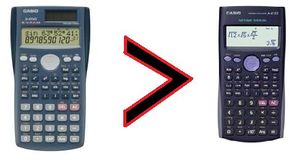The Unit of Fail
The Unit of Fail, measured by units of malpass, is the SI unit of failure.
Definition[edit | edit source]
1 Malpass is the amount of failure achieved by throwing a bottle at a bin from one meter away and missing, fail increases with the square of the distance that said bottle missed the bin by.
The symbol of the unit is 'Mal'
Degrees of Failure[edit | edit source]
As the Malpass is a very small unit, there are several degrees of failure that must be defined using it. These are defined as follows:
- Epic Fail - Failures of 1 MMal or higher
- Legendary Fail - Failures of 1 GMal or higher
- Ludicrous Fail - Failures of 1 TMal or higher
The System in Practice[edit | edit source]
A series of examples of applications of the Malpass:
- Any and all attempted pickup lines 2.6 kMal
- The Statue of Peter the Great in Moscow 5.6 kMal
- Windows ME 1.5 MMal
- Windows Vista 1.8 MMal
- The Russo-Japanese War 1.5 TMal
- The global economy 10.1 MMal
The Unit of Success[edit | edit source]
As failure is the inverse of success, the unit of success can therefore be defined as an inverse Malpass, Mal-1. Success can also be defined in Clares (Cla).
1 Cla = 1 Mal-1
Discovery of the Malpass[edit | edit source]
Failure is not just an arbitrary phenomenon. The current prevalent theory is that failure is in fact caused by the passage of mass through a 'fail field'. Every object with mass generates a fail field, but the field strength varies widely dependent on a set of unpredictable variables. However, the most recent theory is that as failure is now considered to be a field, it must be facilitated by an exchange particle (boson). This particle, much like the graviton and Higgs' Boson, has evaded all attempts to isolate it or prove its existence. It has been provisionally dubbed the Hollett Boson. The Malpass was found as an attempt to quantify the effects of this universal field.
The Spi Wave Interaction Postulate[edit | edit source]
Taken alone, however, the 'fail field' does not provide a complete explanation for the source of failure. Recent experiments, however, have shown that there are two other elements involved in incidents of failure - both the acceleration of an incident towards failure and the presence of a mysterious type of wave. The wave is virtually undetectable, and was only found after an extremely powerful source in the form of a physicist was discovered. The discoverers of the new wave dubbed it the Spi wave and wondered whether or not it was connected to the uncannily large number of incidents of spontaneous lab equipment breakages in the presence of the physicist.
More pieces of the puzzle began to click into place with the realisation that the acceleration towards failure implies some kind of 'fail force' operating on objects. When we consider the model of electromagnetism, the way to combine these disparate elements into a unified theory is obvious.
Spi waves, due to their very nature, generate a circular fail field. When a Spi wave passes in a perpendicular direction through a plate-to-plate fail field of the type which often occurs between objects, there is a catapult field effect similar to that shown in electromagnetism. In practice, this means that a large force is induced in a direction mutually perpendicular to the fail field and spi wave. This 'fail force' is what causes the actual failure, creating the acceleration effect.
Whilst it is a compelling theory, the Spi Wave Interaction Postulate is still considered unacceptable by many cake physicists who wish that they thought of it first.
Newly Observed Phenomena[edit | edit source]
Field studies carried out in Southampton, UK have discovered new Fail phenomena, such as the 'fial' effect (observed when a technician attempting to press 7 on an alphanumeric keypad missed and pressed both 6 and 7), and the effects of alcohol as a Fail multiplier. Further studies are underway, however, early results indicate that exciting developments in the field of Fail Theory are almost below us.
Discovery of Fail Cloak[edit | edit source]
Recent studies have shown that in some limited cases certain conditions give rise to a 'fail cloak'. This enables the failer to go largly undetected as a fail unless view by experts in the field. This has led scientists in the field to conclude that a new particle, named the 'Duff', exists, Its main properties are high speed but without any use. When viewed from a distance the particle appears to be interacting with many other particles and causing work to be done, however on closer inspection it shows that this is sadly an Illusion. Any time the Duff does interact it cause the creations of a Duff Fail Cloak Field temporarily. This leads to the observed fail cloak. More Research Pending.
